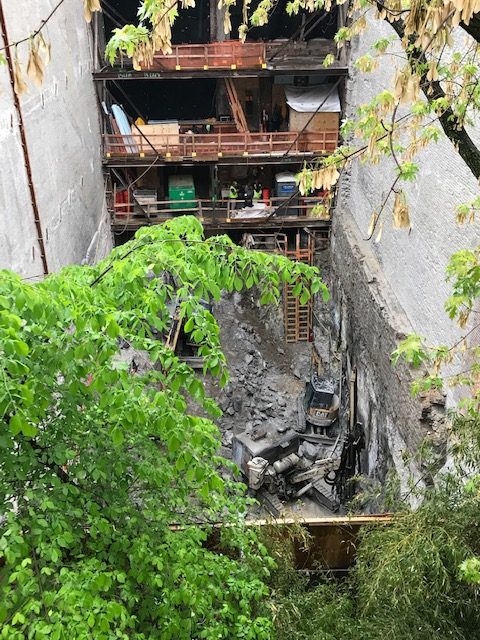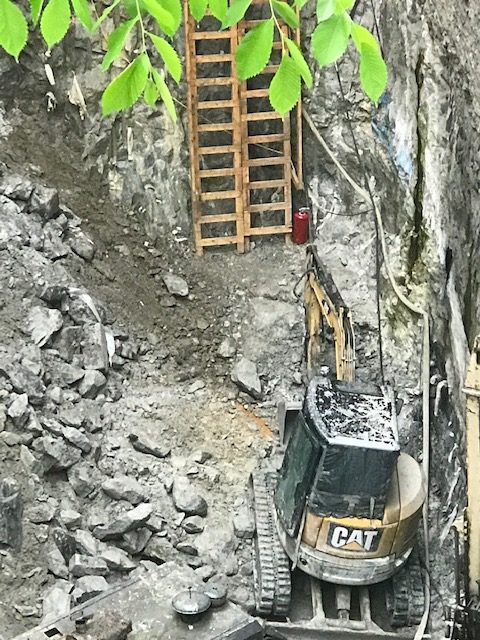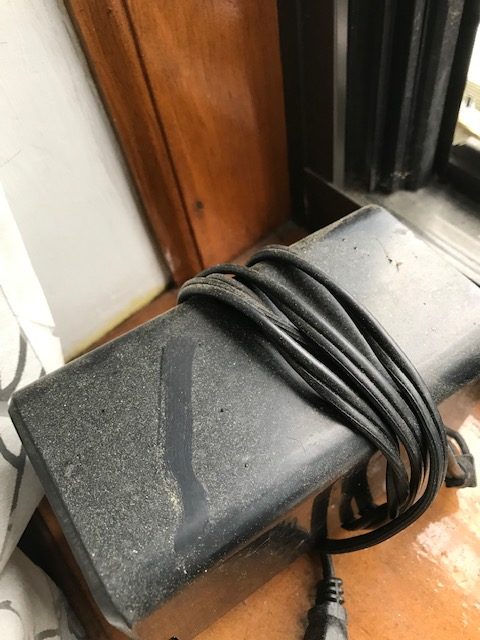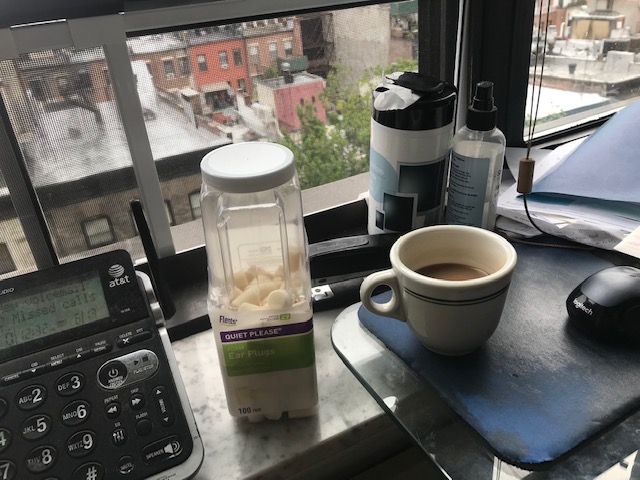
The private swimming pool being dug on West 69h Street in Manhattan
They pleaded for relief from local politicians. One installed a decibel meter on her cell phone. Others wore high-grade earplugs. A few left altogether, decamping for quieter surroundings.
David Margolick is one of those neighbors. He’s also a journalist. His solution: To write a deliciously barbed story, “That Noise? The Rich Neighbors Digging a Basement Pool in Their $100 Million Brownstone,” about the cacophonous construction going on in the middle of West 69th Street. As he notes it in a no-holds-barred nut graf:
This is about how the whims of a plutocrat can upend the lives of an entire city block, challenging the culture and the well-being of the people who live there. It’s about coming to terms with everyday existence in New York, where the rich run rampant and the rest of us have to deal with it.
The story struck a chord far beyond the Upper West Side. More than 1,500 readers added their views in online comments. Many decried the project as yet another example of supergentrification, where the ultra-wealthy transform once lower- and middle-income neighborhoods to satisfy their desires, pricing long-time residents out of their communities.
“Enough,” wrote one reader. “The super-rich are a scourge on our society that must somehow be stopped.”
“Selfishness is king,” another said. “Disrupt the lives of everybody on the block for years so you can have your luxury. It’s the same story of all gentrification: they think this is the best block in the city, but their selfish greed is destroying it.”
Of course, in the odd democracy that is online commenting, there was another sentiment, this one directed at aggrieved neighbors: Suck it up or move to Vermont.
“That Noise?” ran April 5 in the Sunday Metropolitan section of the New York Times, which is mecca to some of the Times’s most stylistic flourishes. It was an apt destination for Margolick, book author, former legal affairs correspondent for the Times, and longtime contributing editor of Vanity Fair.In this piece, his prose is studded with linguistic devices that delight the ear, and diction that, at times, requires dictionaries — both English and Yiddish — to fully appreciate his love of the written word. This is a story meant to be read aloud.

David Margolick
His reporting shows similar depth. He describes the swimming pool pit as a chasm “going down 37 feet, 11 ½ inches, (as if) a meteor, of the sort that killed off the dinosaurs, has struck.” Construction workers tunnel into “Manhattan’s famously stubborn schist,” while work ceases only for holidays of the “politically potent — Christmas and Rosh Hashana, for example, but not Martin Luther King’s Birthday.”
The project is maddening but it’s clear that Margolick had a blast writing about it. After tracking down the project’s plans, he inserts a snippet of snark: “The finished mansion will feature an underground theater and a recording studio, a Jacuzzi and a sauna, free-floating elliptical stairs (whatever that might be) and a wall of sculpture depicting trees, animals and birds of the jungle.”
He turns up a diverse collection of furious and frazzled neighbors: The violinist forced out by jangly nerves and fears of pulmonary disease; the lawyer who fled after her landlord suggested she take her privileged documents to a coffee shop; and hold-out Nick Jordan, 80, a philosophy professor who hoped to outlive the racket but worried about its impact. As he noted: “Schopenhauer argued that the higher your tolerance for noise, the lower your intelligence.”
Margolick waits until well into the story to disclose his own residency, but does not mention that he wears Flents Quiet Please foam earplugs to buffer the din.
In his author persona, Margolick is working on a book about the comedian Sid Caesar’s 1950s TV programs “Your Show of Shows” and “Caesar’s Hour,” whose writers included Mel Brooks, Neil Simon and Larry Gelbart. He did a 2014 New Yorker sketch about Caesar, and obviously has picked up some tips about comic timing. In “That Noise?” he writes about the unearthed stones that are dispatched to New Jersey “where they are reincarnated as concrete.” And then he tells the story of the Tormeys.After James Tormey, the tenant relocated from No. 48, died in 2016, his wife, Deborah Tormey, returned to sprinkle his ashes around the pagoda tree. And a good thing, too: had she strewn them in the back yard, he, too, would have landed in Piscataway.
Margolick sets up a kicker quote by noting the residents “napped” as the project made its way through the city’s approval process, no one suspecting “excavations out of Jules Verne.”
They just talked about putting two buildings together, and we just said O.K.” one recalled. “No one thought they were going to be jackhammering into the center of the earth.
But the story has an even more whimsical ending, a second kicker in the form of a correction:
An earlier version of this article misidentified a cat that had taken to overgrooming because of the construction noise. Its name is Titania of the Grey, not Titania of the Greil.
I was both enchanted and outraged by the story. So I asked Margolick about the story in a series of email and phone exchanges. Our conversation has been lightly edited for length and clarity.

The deep dig under brownstones in the Upper West Side, where a couple is planning an underground recreation center, complete with a swimming pool
Tell me about the origins and placement of “That Noise?” It could have been a personal essay, or a column, yet you wrote it as a narrative. Why?
For many months, I’d been bothered by the noise coming from a nearby construction site. I have a birds-eye view of it, since I’m on the ninth floor of a building one block to the south. Dismantling two adjacent brownstones hadn’t disrupted things, but then the drilling started, jarring and incessant. And not surprisingly: it turns out they were going down nearly thirty-eight feet into the bit-breaking rock upon which Manhattan sits, in part to build a swimming pool and spa. My first impulse was to write a screed, since I work at home, sit by my window, and have to listen to this all day. Then I realized that 1) No one cares about my complaints, and 2) It would be much more interesting to find out what was happening, and how it had come to pass. Whatever I found would be a slice of New York life circa 2019.
With its rich catalogue of status details, a layered structure, limited attribution and a tone that ranges from outrage to awestruck to snark, your story has all the hallmarks of a classic narrative — one masquerading as a news feature. How did your experience as a magazine contributor and author influence how you wrote this story? Did you get any resistance from Times’ editors about the way you pushed the envelope?
I never really thought about the tone of the story. I knew it had to be more personal than a news story because I had a stake in it (albeit a minor one). This was actually liberating: I wouldn’t have to write with the usual detachment. And the place where it ran, the Times’ Sunday Metropolitan section, freed me further. I’m still very much a reporter — I want to tell stories, rather than pop off — but I’ve reached a point where I want to take greater stylistic liberties, to have more fun. After many years of working at the Times and a lifetime of reading it, I also think I have a sense for how far one can go, which is farther than it once was. And at that point, of course, one has to try to go farther still. (A good editor, like Bill Ferguson, whom I was lucky to have in this instance, actually wants that.)
That said, the best approach is still to let the people and facts speak for themselves. The story had a wonderful cast of characters; everywhere I turned, up and down the block, there they were. Much of my job consisted of simply setting up what they had to say.
Your creative use of literary devices — metaphor (“a Potemkin-like sop”), alliteration (“stubborn schist”) and analogies (“It’s as if stone that sat intact and undisturbed for millenniums beneath what would eventually become Manhattan is shrieking, ‘And all this for … a swimming pool?’) — also makes this a fun read. How do you come up with these? Are they part of your notetaking, or happen while sitting at the computer?
These things just emerge the fifth or ninth or nineteenth time you go through a piece. Alliteration is so wonderful that I have to resist the temptation to over-use it. I think I’d happened to read something about meteors and dinosaurs as I was writing the piece. The trick is not to censor yourself: If these images occur and they work, why not use them, as long as they’re not pompous or obscure or belabored? I got no pushback on any of them because, again, a good editor appreciates — is relieved by — bright writing.
Your nut graf pulls no punches. What gave you the confidence to make such a sweeping and damning claim without attributing it to some “expert” source?
In this instance, (editor) Bill Ferguson actually insisted upon it. The paper is trying harder to level with its readers, to drop its air of Olympian detachment. It’s something to which older, more traditional reporters like me have to adjust. He explained that you have to pique the readers’ interest quickly. There has to be some way to step back and summarize where you’re going with this.
The reporting is meticulously detailed, from the health effects on neighbors — human, canine and feline — to the construction process and the description of the owners’ plans for an ostentatious underground entertainment center. How did you report the story?
I sought out the presidents of the block associations on West 69th St., where the mansion will go, and West 68th St., where I live. I asked them for the names of residents closest to the construction site. To make sure I got diverse points of view, I asked those people for additional names, and also spoke to random people on the street. I went to several block association events. I also needed to identify the husband and wife who are responsible for the project, since they are hiding behind a corporate shell. This was something that virtually no one in the neighborhood had yet managed to do, but I did in surprisingly short order.
Because the man in the couple is a French businessman, I hired a French-speaking researcher to check the French and Belgian papers for information about him. Because she is a jazz singer, I checked out various musical websites, including a podcast in which she expressed great concern for rocks, trees, animals, air and various other entities her vanity project has disrupted. I never spoke to them, but it wasn’t for lack of trying. Apart from contacting publicists, I reached out to all three architects who’d worked on the project; the owners’ lawyer; their representative on the construction site; one of their fellow investors in various cultural productions they’ve backed; and the Juilliard School, where he’d been a trustee, and set up a scholarship for struggling jazz musicians. (The violinist forced to flee because of the disruption — a move that set her back $5,000 — might have appreciated some of that largesse.)
Since the plans for the house were online, many details about it were available, though some of its more intriguing features came from additional interviews. The commute was easy; I just had to roll out of my apartment and walk a block.
How long did the story take?
I was always working on other things. Probably off and on for two months. This was strictly a spare time kind of thing. I did this story on spec.
Do you do a lot of work on spec?
I do so more now than I ever have. I want to do what I want to do and I have enough faith in myself that I think I can sell it to someone. Last year, on the 50th anniversary of his assassination, I sold a 4,500-word piece on Bobby Kennedy’s last flight, which carried his body back from California for the funeral. That was an amazing experience. I gave it to The Washington Post on a Friday; by Monday it was in the paper. It’s easier to present someone with a fait accompli than it is to pitch.
You’re such a masterful stylist; are there role models or influences you can point to?
I went to a private school where we had to do a lot of reading. I always admired the Southern literary tradition. If you read “Of Time and the River” or “You Can’t Go Home Again” by Thomas Wolfe, “All the King’s Men” by Robert Penn Warren, or anything by Faulkner, you pick up some of the rhythm and musicality of the prose. I love those long and undulating sentences. Walt Whitman and Proust, too.
Maybe a tiny bit of them managed to seep in.

Dust from the construction that gathers on windowsills inside neighboring apartments
Deep in the story, you reveal that you were one of the residents affected by the construction. Why did you wait so long to disclose that, or disclose it at all?
I didn’t think it was a big deal. I live a block away, so have been affected by the construction far less than those closer by. But because I left that unclear, I left myself open to criticism.
What were the biggest surprises about this story?
When I started, I was aware of little more than jackhammers. Most surprising was the scale of everything — the expenditures, the disruption, the outrage of the residents and indifference of the owners. And their callousness — or, really, hers, since he’s remained silent. Without pointing to a single mistake, she tweeted that piece was “fake news.”
I also meant to shed light on such self-involved New Yorkers. I like muddying things up, reminding people that life is complicated, that no side has a monopoly on virtue, and that piety is often a cover for hypocrisy.

David Margolick keeps a jar of earplugs nearby as he writes to the neighborhood's construction noise
Less surprising, I guess, but equally noteworthy were the tendrils of community that emerge in the big, impersonal city if you care enough to look for them. The story reminded me that if you get out and listen and ask the right questions, people invariably have surprising and delightful and poignant things to say. Ask a professor who teaches these guys whether any famous philosopher ever wrote about noise, and he might just tell you, “Schopenhauer.” Ask a retired magazine editor how her poodle is handling the situation and the dog is on Trazodone, and read you the prescription: “One tablet orally up to three times daily as needed for calming during construction.”
What’s been the reaction been to the story, and where does the story stand?
It may be a New Yorker’s typical conceit, but I assumed all along that there’s nothing parochial about a classic New York story, and that any story about wealth run amok would have universal appeal, which this one had: it made the Daily Mail and Le Monde, and had nearly a million page views, and elicited more than 1500 comments, from all over the place.
Meanwhile, as you can hear at this very moment in the background, the drilling and banging continue. I can have fresh air or quiet but not both (unless I wear those earplugs).
